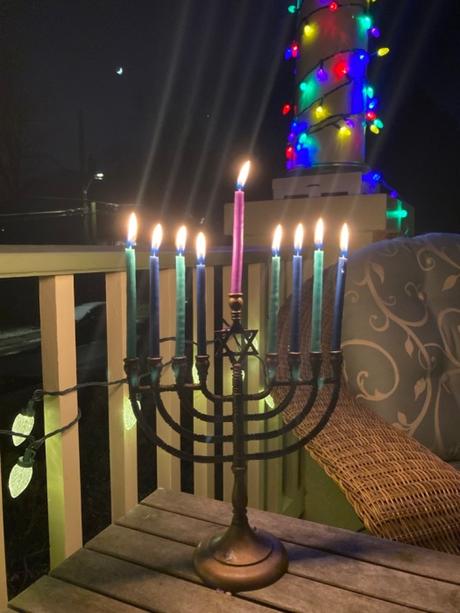
The solar Gregorian calendar determines the timing of Christian holidays, while both the sun and moon guide the Jewish calendar. As a result, each year interfaith families who celebrate both must choreograph the dance of Hanukkah and Christmas in a new way. In 2022, the last night of Hanukkah falls on Christmas Day. So this year, I am updating this guide because the dance will require some expert steps.
The convergence of the two holidays increases the complexity of preparation, and coordination, in order to give each its own time and space and integrity. But after more than 60 years of celebrating both holidays, I know that it can be done, without actually mixing or blending or fusing the two together. So here are my eight strategies for a nimble Hanukkah and Christmas dance this year:
1. Accept that balance occurs in the course of a year, not every day. On Christmas, it's natural for those who celebrate both holidays to lean into Christmas. So in a year like this one, when Hanukkah ends on Christmas, why not shift the emphasis on Hanukkah to the start of the eight-day holiday? Try starting Hanukkah with mindful intention, and set the tone for the holiday early in the week, before the overlap with Christmas festivities.
2. When traveling, check your interfaith packing list. If you are going to be staying with Christian family members, remember to pack the Hanukkah menorah! (And, here's a great children's book about an interfaith family who forget to pack their menorah). In the excitement of Christmas Eve and the exhaustion at the end of Christmas day, don't forget to set aside a few minutes to gather everyone to light candles for the last two nights of Hanukkah. This is a year to enjoy the synergy of a glowing Hanukkah menorah and a sparkling tree, and talk about the common theme of light at the darkest time of year. (And, an important safety tip: If you are going out to a church service or caroling, be sure the candles are safely burned out before you leave the house!)
3. Give Hanukkah gifts at the start. Consider frontloading gifts at the start of Hanukkah this year, rather than competing with Christmas at the end of the week. Some families like to emphasize books and clothes as Hanukkah gifts for children, rather than toys, to further differentiate the two holidays. Try to resist the false competition between the holidays that has given rise to the idea of piles of Hanukkah gifts. Be confident that when they are grown, children will remember lighting the candles, as much as a game or toy.
4. Time the parties. This year, Christmas lands squarely on the last weekend of Hanukkah. So for families who celebrate both holidays but want to keep them separate, the first night of Hanukkah, Sunday December 18th, is the obvious night this year to throw a Hanukkah party without overlapping with Christmas. Personally, I can barely fry enough latkes for my own crew. So in my family, we gravitate towards the simple weeknight vegetarian (or vegan) Hanukkah supper consisting of latkes, apple sauce, and salad. And as the pandemic continues, these intimate celebrations are a wise choice.
5. Tell the Hanukkah story. The religious freedom aspect of the Hanukkah story resonates in interfaith families drawn to social justice themes. We are lucky to live in a time and place with the freedom to marry for love, and to celebrate either, or both, or any religion. And we need to stand ready to protect the right for everyone to marry without restrictions on race, gender, and religion. Singing the Hanukkah song Rock of Ages (different from the Christian hymn of the same name) with English lyrics rather than Hebrew on the nights you celebrate with extended Christian family members will make the story, and the theme of opposing tyranny, more accessible to all.
6. Give to others. The final nights of Hanukkah this year would be perfect for giving back, in lieu of more gifts that compete with Christmas gifts. Stress that both holidays encourage us to care for those in need. Let children know that the legend of Saint Nicholas has him giving to the poor and the hungry. Engage children in deciding what causes they want to support with charitable donations for both holidays this year.
7. Organize acts of service. Christmas encourages empathy for those who, like Mary and Joseph, must travel and seek shelter. Hanukkah provides an opportunity to reflect on how Jewish history compels us to work to promote social justice. Celebrate these intertwined themes by planning and engaging in acts of service together to support refugees and religious minorities in the new year.
8. Try not to stress. As you move through the dance of Hanukkah and Christmas this year, don't fret over a misstep or two. Many of us forget to light candles on occasion. Many of us feel judged, or still judge ourselves, for how we mark December holidays. Everyone has a different comfort level with where to place the Hanukkah menorah in relation to the Christmas tree. Through it all, do your best to find the still, small moments that create holiday peace and joy.
Journalist Susan Katz Miller is an interfaith families speaker, consultant, and coach, and author of Being Both: Embracing Two Religions in One Interfaith Family (2015), and The Interfaith Family Journal (2019). Follow her on twitter @susankatzmiller.
